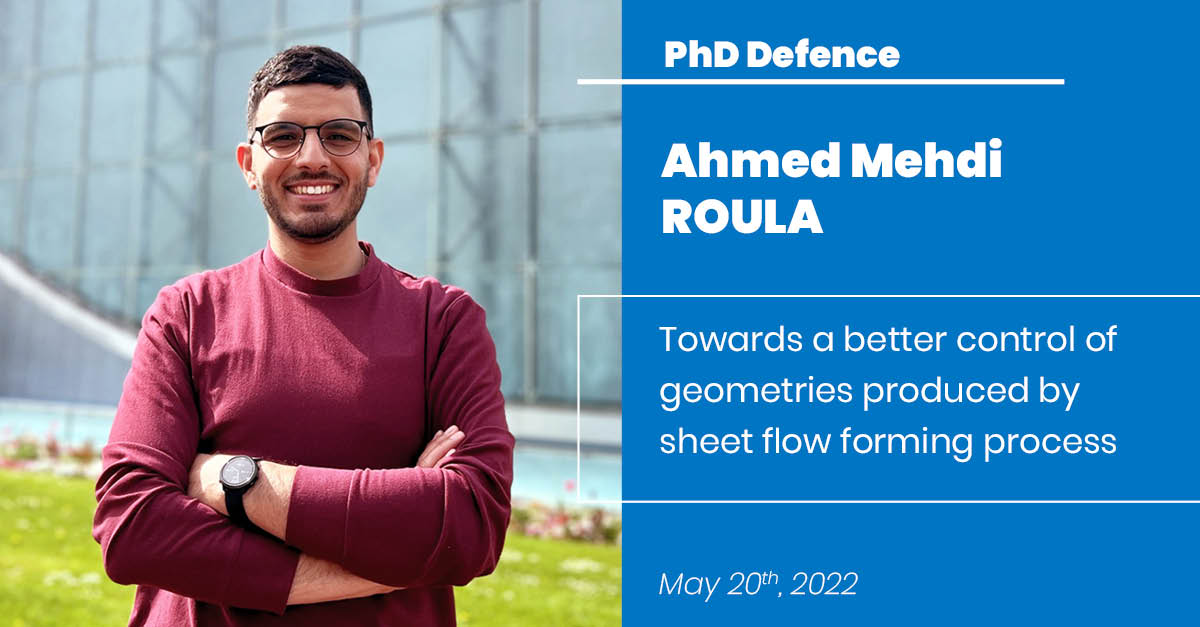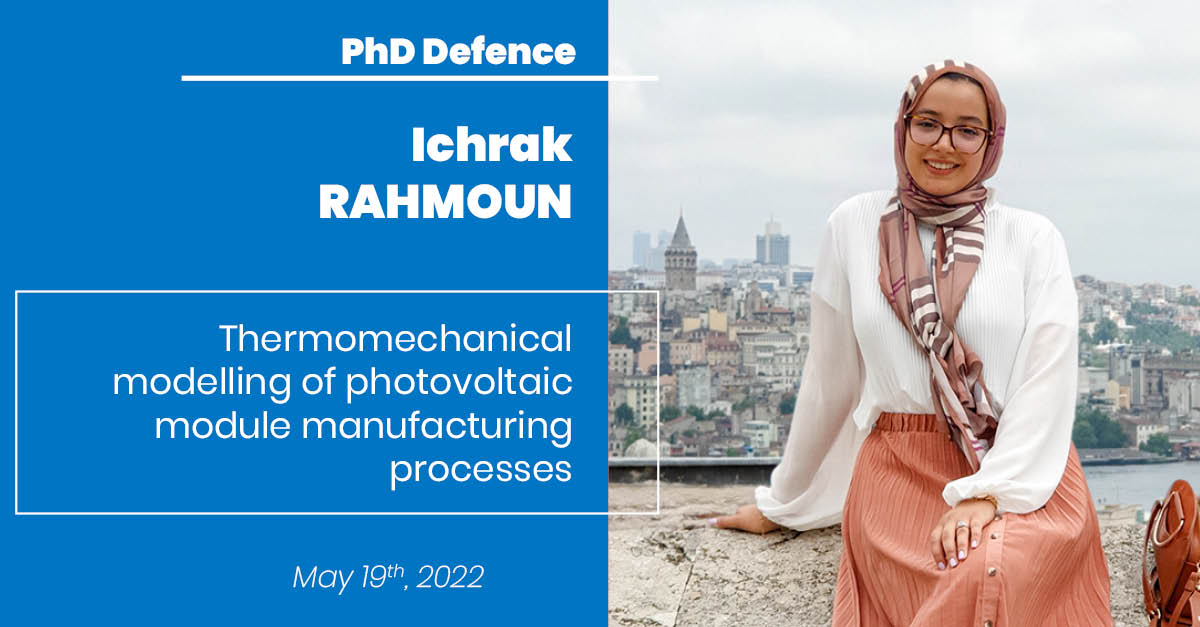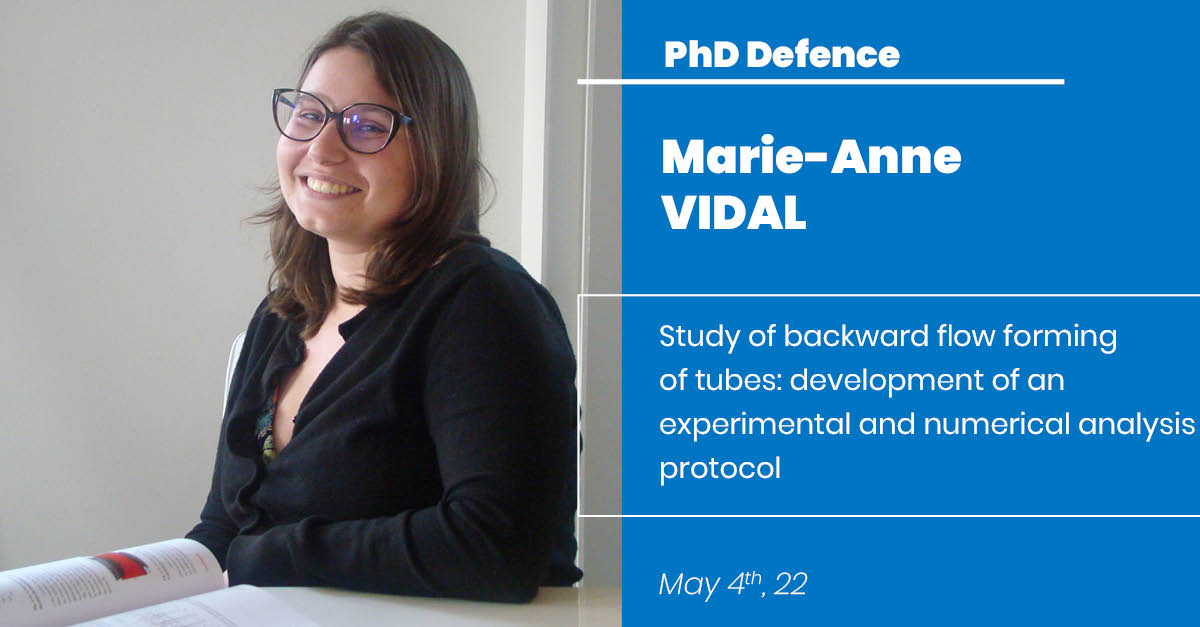Theme: Research
Coraline Chartier, awarded at the AFPM Conference
Congratulations to Coraline Chartier, 3rd year PhD student.

PhD defence of Ahmed Mehdi Roula
Ahmed Mehdi Roula defends his PhD in Computational Mechanics and Materials on May 20th, 22
"Towards a better control of geometries produced by sheet forming process."

Ahmed Mehdi Roula conducted his PhD work in the CSM team. He defends his PhD in Computational Mechanics and Materials on May 20th, 2022 in front of the following jury:
Phd defence of Ichrak Rahmoun
Ichrak Rahmoun defends her PhD in Computational Mechanics and Materials on May 19th, 22
Thermomechanical modelling of photovoltaic module manufacturing processes

Ichrak Rahmoun conducted her PhD work in the CSM team. She defends her PhD in Computational Mechanics and Materials on May 19th, 2022 in front of the following jury:
– Prof. Veronica Bermudez, Qatar Environment and Energy Research Institute
– Prof. Cyrille Sollogoub, CNAM
– Prof. Corinne Alonso, Université de Toulouse Paul Sabatier III
– Prof. Fabrice Schmidt, Mines Albi
– Prof. Jean-Luc Bouvard, Mines Paris
– Prof. Pierre-Olivier Bouchard, Mines Paris
– IR Aude Derrier, CEA Liten
Abstract:
Photovoltaic (PV) modules consist of active photovoltaic layers (Silicon, passivation), protective encapsulation layers (polymers) and glass plates. The performance and service life of PV modules depends on their ability to withstand various environmental constraints related to thermomechanical, physical, chemical and / or electrical phenomena. In the context of this work, we will focus on the residual stresses induced during manufacturing. This comprises the electrical interconnection between the PV module cells, by welding or adhesive bonding of conductive lines, and the protective encapsulation by layers of polymers and glasses using lamination process (hot pressing). The induced residual stresses can be at the origin of failures observed on the modules (delamination, cell cracking, breakage of interconnections …etc.), either at the manufacturing stage or during the lifetime of the modules due to the service constraints. The objective of this PhD thesis will be to model the encapsulation and interconnection processes of cells to better understand their influence on the main failures observed on the modules.
Keywords: Photovoltaic module, lamination process, interconnection process, thermomechanical modelling, residual stresses
PhD defence of Marie-Anne Vidal
Marie-Anne Vidal defends her PhD in Computational Mechanics and Materials on May 4th, 22
Study of backward flow forming of tubes: development of an experimental and numerical analysis protocol

Marie-Anne Vidal conducted her PhD work in the CSM team, under the supervision of Katia Mocellin and Pierre-Olivier Bouchard. She defends her PhD in Computational Mechanics and Materials on May 4th, 2022 in front of the following jury:
PhD defence of Charles Brissot
Charles Brissot defends his PhD in Computational Mechanics and Materials on April 14th, 22
Numerical and experimental study of boiling flows – Application to quenching

Charles Brissot conducted his PhD work in the CFL team, under the supervision of Elie Hachem and Rudy Valette in the framework of the ANR Industrial Chair INFINITY. Charles defends his PhD in Computational Mechanics and Materials on April 14th, 2022 in front of the following jury:
Abstract:

Keywords: Boiling, Quenching process, Phase Change, Vaporisation, Finite Element Method, Level Set method
PhD Defence of Brayan Murgas Portilla
Brayan Murgas Portilla defends his PhD in Computational Mechanics and Materials on April 7th, 22
Towards a precise description of the grain boundary mobility and energy for their numerical integration in finite element modeling of recrystallization and grain growth mechanisms.

Brayan Murgas Portilla conducted his PhD work in the MSR team, under the supervision of Nathalie Bozzolo and Marc Bernacki. Brayan defends his PhD in Computational Mechanics and Materials on April 7th, 2022 in front of the following jury:
Abstract:

Grain growth simulation in an austenitic steel at 900°C using EBSD data
Keywords: Finite Element Method, Level-Set, Grain Boundary, Grain Boundary Mobility, Grain Boundary Energy, Anisotropy

